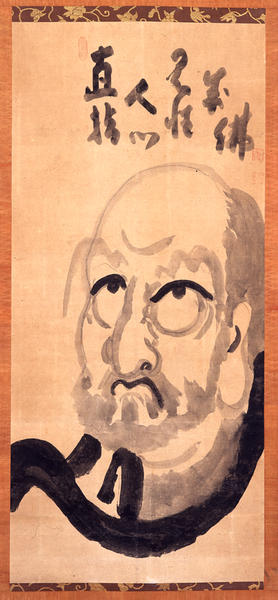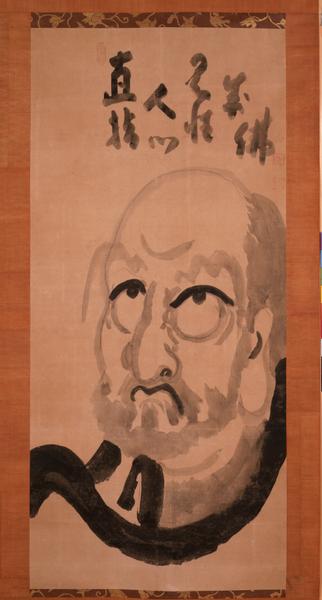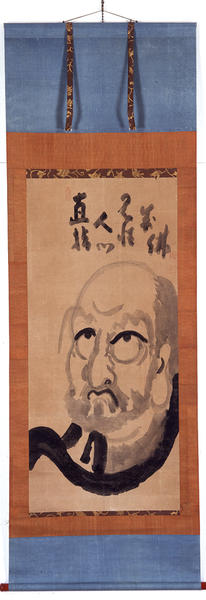達磨図(白隠慧鶴筆)
- 江戸時代
- 18c
- 紙本墨画墨書
- H-125.1 W-57.3
解説(開館1周年記念展)
白隠慧鶴は江戸中期の禅僧で,臨済禅中興の祖といわれる。駿河(静岡県)原駅の出身で,余技としての画や書を民衆の教化に用い,「駿河には過ぎたるものが二つあり,富士のお山と原の白隠」と土地の人々に慕われた。たゆまざる求道精神をもち,孔孟・老荘思想は言うに及ばず,広く内外の教典,更に晩年には神道研究にまで及び,その視野はまさに世界性をもっていたと言える。
その画は禅師の強い欣求の精神を備えた特異な作風が特徴で,本作のような達磨図は数点が伝えられている。薄墨を基調に,瞳と上瞼,口,耳穴,衣を濃墨で描いており,茫漠とした風貌の奥に秘められた強靭な意志を感じるところから,晩年の自画像のような印象を受ける。「直指人心見性成佛」とは,端的に言えば座禅により自己に本来備わっている仏性を発見し,真の悟りを得ることである。
Catalogue Entry
Born in Hara, Suruga Province (present-day Shizuoka Prefecture) in the 18th century, Hakuin Ekaku was a Zen priest, who is considered to be the father of the Rinzai Zen Sect. He made use of his skills in painting and calligraphy to promote the teachings of Buddha and to enlighten people. The people of Suruga, in turn, spoke of him fondly, by fashioning a phrase "There are two things that are almost too good for Suruga Mt. Fuji and Hakuin of Hara." With a tireless desire to pursue learning, he studied the teachings of Confucius and Mencius, and the philosophy of Lao-tze and Chung-tze, not to mention other books of teachings from in and outside of Japan. In his mature years, his interest took him to the study of Shintoism as well. In all, his horizon of interests expanded beyond the local confines.
Hakuin had a strong individualistic style that manifested his sincere rejoicing of his search for the Buddha nature. Several portraits of the Zen patriarch Bodhidharma like the present work are known to exist. Hakuin used thin ink to set the basic tone of the piece, to contrast with the thick ink he used for the pupils, eyelids, lip, ears, and the robe. An unflagging will that comes through the rather vague look of Bodhidharma may very well be fitting as Hakuin's self-portrait in his mature years. The calligraphy above the portrait makes his belief known, that through Zen meditation, one discovers the Buddha nature with which one is endowed from birth and arrives at the true spiritual awakening.
解説(春の玉手箱)
白隠慧鶴は江戸時代中期の禅僧で、臨済禅中興の祖といわれる。駿河(静岡県)原駅の出身で、余技としての画や書を民衆の教化に用い、「駿河には 過ぎたるものが二つあり 富士のお山と原の白隠」と土地の人々に慕われた。たゆまざる求道精神をもち、孔孟・老壮思想は言うに及ばず、広く内外の経典、更に晩年には神道研究にまで及び、その視野はまさに世界性を持っていたと言える。
その画は禅師の強い欣求の精神を備えた特異な作風が特徴で、本作のような達磨図は数点が伝えられている。薄墨を基調に、瞳と上瞼、口、耳穴、衣を濃墨で描いており、茫漠とした風貌の奥に秘められた強靭な意志を感じるところから、最晩年の自画像のような印象を受ける。「直指人心見性成佛」とは、端的に言えば座禅により自己に本来備わっている仏性を発見し、真の悟りを得ることである。


